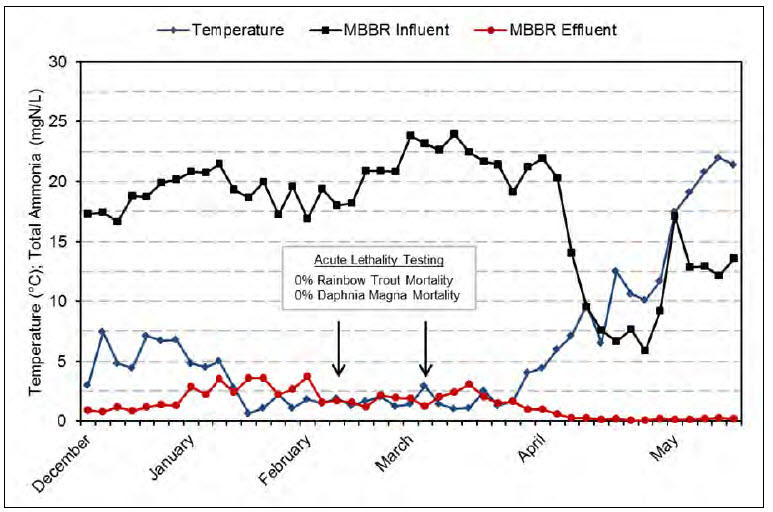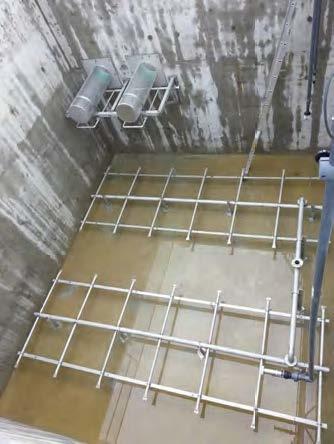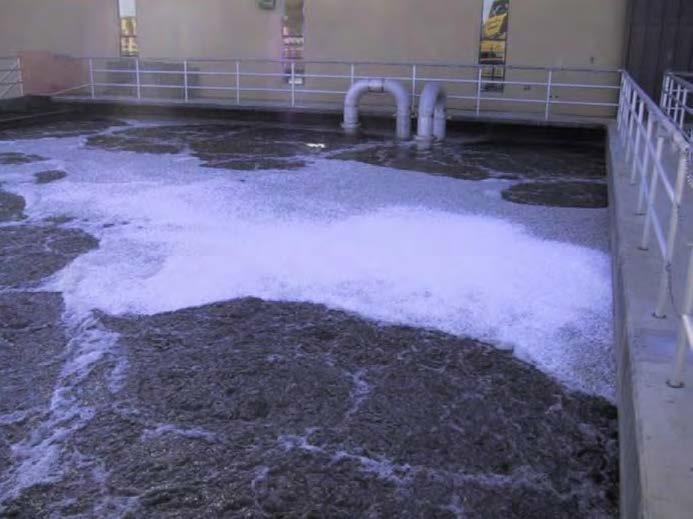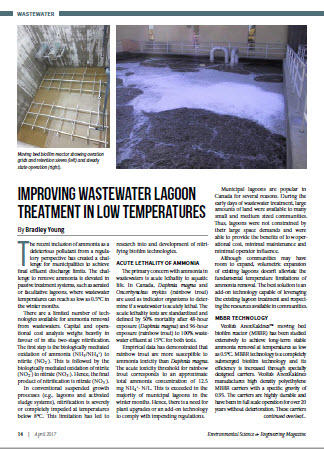Improving Wastewater Lagoon Treatment in Low Temperatures
The recent inclusion of ammonia as a deleterious pollutant from a regulatory perspective has created a challenge for municipalities to achieve final effluent discharge limits. The challenge to remove ammonia is elevated in passive treatment systems, such as aerated or facultative lagoons, where wastewater temperatures can reach as low as 0.5°C in the winter months.
There are a limited number of technologies available for ammonia removal from wastewaters. Capital and operational cost analysis weighs heavily in favour of in situ two-stage nitrification. The first step is the biologically mediated oxidation of ammonia (NH3/NH4+) to nitrite (NO2-). This is followed by the biologically mediated oxidation of nitrite (NO2-) to nitrate (NO3-). Hence, the final product of nitrification is nitrate (NO3-).
In conventional suspended growth processes (e.g., lagoons and activated sludge systems), nitrification is severely or completely impeded at temperatures below 8°C. This limitation has led to research into and development of nitrifying biofilm technologies.
Acute Lethality of Ammonia
The primary concern with ammonia in wastewaters is acute lethality to aquatic life. In Canada, Daphnia magna and Oncorhynchus mykiss (rainbow trout) are used as indicator organisms to determine if a wastewater is acutely lethal. The acute lethality tests are standardized and defined by 50% mortality after 48-hour exposure (Daphnia magna) and 96-hour exposure (rainbow trout) to 100% wastewater effluent at 15°C for both tests.
Empirical data has demonstrated that rainbow trout are more susceptible to ammonia toxicity than Daphnia magna. The acute toxicity threshold for rainbow trout corresponds to an approximate total ammonia concentration of 12.5 mg NH4+- N/L. This is exceeded in the majority of municipal lagoons in the winter months. Hence, there is a need for plant upgrades or an add-on technology to comply with impending regulations.
Municipal lagoons are popular in Canada for several reasons. During the early days of wastewater treatment, large amounts of land were available to many small and medium sized communities. Thus, lagoons were not constrained by their large space demands and were able to provide the benefits of low operational cost, minimal maintenance and minimal operator influence.
Although communities may have room to expand, volumetric expansion of existing lagoons doesn’t alleviate the fundamental temperature limitations of ammonia removal. The best solution is an add-on technology capable of leveraging the existing lagoon treatment and respecting the resources available in communities.
MBBR Technology
Veolia’s AnoxKaldnes™ moving bed biofilm reactor (MBBR) has been studied extensively to achieve long-term stable ammonia removal at temperatures as low as 0.5°C. MBBR technology is a completely submerged biofilm technology and its efficiency is increased through specially designed carriers. Veolia’s AnoxKaldnes manufactures high density polyethylene MBBR carriers with a specific gravity of 0.95. The carriers are highly durable and have been in full scale operation for over 20 years without deterioration. These carriers are designed to have a protected interior surface for biofilm growth and to remain in constant movement in the reactor.
For nitrification, the constant movement of the MBBR carriers is generated by the aeration system of the reactor.
The aeration system can support carrier volumes of 20% – 60% relative to the total reactor volume. The MBBR carriers in an operating system are constantly colliding and subject to hydrodynamic shear forces. These processes act as a self-cleaning mechanism for the carriers and hence enable a healthy attached biofilm to be maintained. The self-cleaning mechanism eliminates the need for backwashing. Carrier retention sieves facilitate hydraulic flows with minimal head loss.

Nitrifying MBBR
A nitrifying MBBR requires four basic influent water quality parameters: soluble biological oxygen demand to total ammonia ratio of less than 1; pH between 6.8 to 8.5; alkalinity requirement of 7.14 g CaCO3/g NH4+-N; and total phosphates greater than 0.1 mg PO4-P/L.
To respect the soluble biological oxygen demand to total ammonia ratio, the nitrifying MBBR is typically installed after the last lagoon in series (final lagoon effluent). This also ensures all ammonia production from sludge digestion is treated prior to final discharge.
In typical municipal wastewater lagoons, pH, alkalinity and total phosphorus requirements are respected without the addition of chemicals. Dissolved oxygen is supplied through aeration for carrier mixing. These attributes allow for low operational expenses, minimal maintenance and minimal operator influence.
Low Temperature Nitrifying
MBBR Studies
The nitrifying MBBR biofilm has been studied extensively at the lab and pilot scale. Most recently, the technology was piloted for over one year at the effluent of the last lagoon in series. The nitrifying MBBR was operated continuously with a hydraulic retention time of 4.4 hours.
The MBBR used Veolia’s AnoxKaldnes K5 carrier. During winter operation, 24-hour composite samples were collected two times per week. All samples were analyzed by an accredited lab facility for ammonia, nitrite, nitrate, total and soluble chemical oxygen demand (COD), total and soluble five day carbonaceous biological oxygen demand (cBOD5), total suspended solids (TSS), alkalinity and total phosphorus. Time and temperature sensitive analyses were measured on site with portable probes. These analyses included temperature, pH and dissolved oxygen.
The lagoon effluent during winter operation was characterized by average concentrations of ammonia of 21.3 mg NH4+-N/L, cBOD5 of 17.3 mg/L, alkalinity of 153 mg CaCO3/L, total phosphorus of 1.5 mg P/L and TSS of 11.3 mg/L. At these concentrations the lagoon was meeting all effluent discharge limits except for ammonia.
During winter operation, the lagoon effluent temperature dropped as low as 0.5°C and averaged 1.0°C for a period of nearly two months. Hence, operating after the last lagoon respected all the water quality parameters with temperature as the limiting factor.
The MBBR operation leading into the cold temperatures was stable and averaged less than 1 mg NH4+-N/L at temperatures between 5°C and 7°C. Subsequent operation at low temperatures maintained an average final effluent ammonia concentration of 2.1 mg NH4+-N/L. In the beginning of February, an unknown contaminant in the feed sharply decreased the pH from 7.1 to 6.8. This corresponds to the known inhibitory threshold for nitrifying bacteria. However, the system performance was marginally impacted with an effluent ammonia concentration of 3.7 mg NH4+-N/L.
On the following sampling point, pH returned to 7.1 and the process maintained steady for the duration of the pilot, with effluent ammonia concentrations less than 2.6 mg NH4+-N/L. This indicates that, at 1°C, the nitrifying bacteria in the biofilm are active and robust to short-term inhibitory events.
The lagoon effluent and MBBR effluent were each tested twice for acute lethality during the trial period, once in February and once in March. For both samples, the lagoon effluent failed the acute lethality test, with 70% mortality of rainbow trout. The MBBR effluent passed the acute lethality test, with 0% mortality of rainbow trout. As such, the MBBR was capable of exceeding the impending regulations with respect to ammonia throughout the critical winter period.
The spring period of piloting corresponded to rapid warming and dilution of the MBBR influent. During this time period, the MBBR process handled the changing conditions and treated the ammonia to near 0 mg NH4+-N/L. Additional benefits of the MBBR include cBOD5 polishing and minimal TSS addition to the effluent.
Originally published in Environmental Science & Engineering Magazine, April 2017.

Moving bed biofilm reactor showing aeration grids and retention sieves

Moving bed biofilm reactor steady state operation



